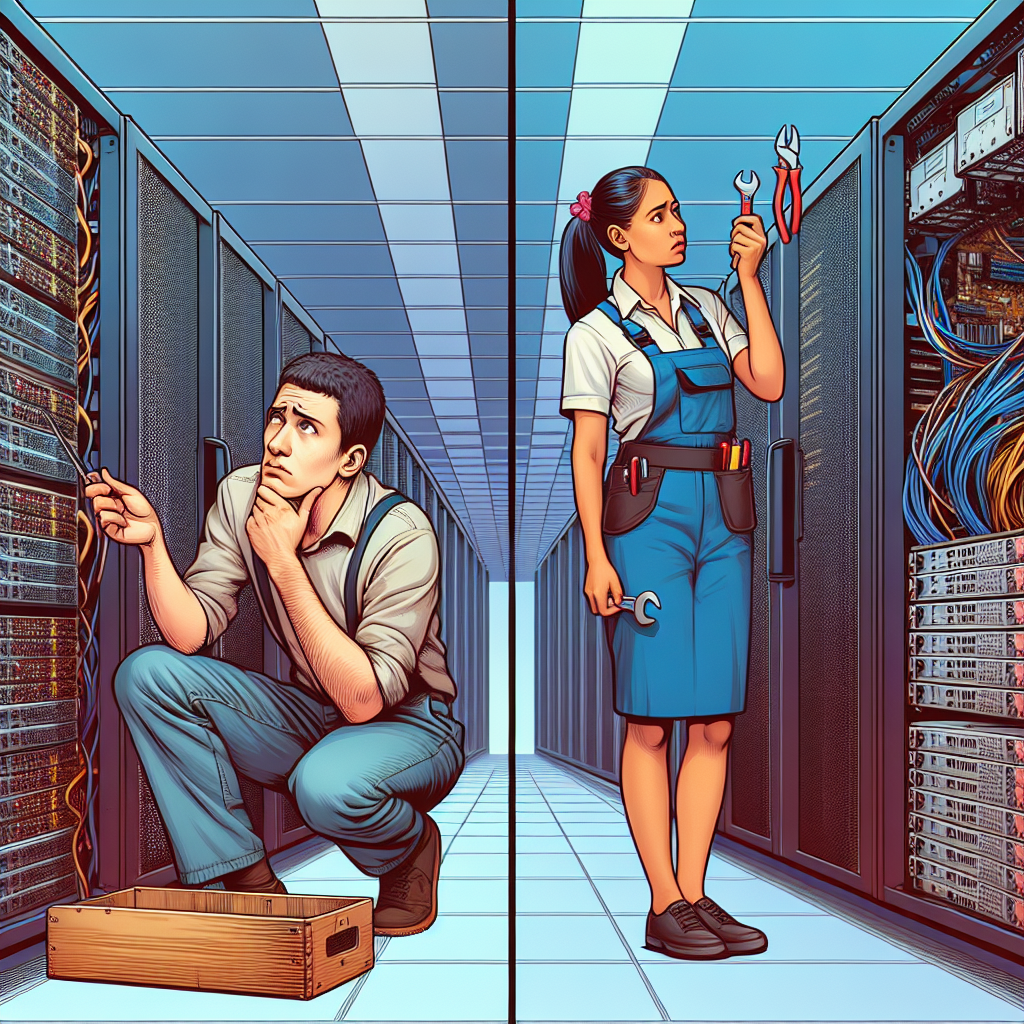Your cart is currently empty!
Tag: Repair

Maximizing Uptime: Best Practices for Data Center Repair and Maintenance
In today’s digital age, data centers play a crucial role in the smooth operation of businesses and organizations. These facilities house the servers, storage, and networking equipment that store and process vast amounts of data. However, like any complex system, data centers require regular maintenance and repair to ensure optimal performance and uptime.Maximizing uptime is a top priority for data center operators, as even a brief outage can have significant financial and reputational consequences. To achieve this goal, it is essential to follow best practices for data center repair and maintenance.
Regular Inspections and Preventive Maintenance
One of the most important steps in maximizing uptime is conducting regular inspections and preventive maintenance. This includes checking for signs of wear and tear on equipment, cleaning dust and debris from servers and cooling systems, and testing backup power systems. By identifying and addressing potential issues before they escalate into major problems, data center operators can minimize the risk of downtime.
Implementing a Comprehensive Monitoring System
Another key best practice for data center repair and maintenance is implementing a comprehensive monitoring system. This system should track key performance metrics, such as temperature, humidity, and power usage, in real-time. By closely monitoring these factors, operators can quickly identify and respond to issues that could lead to downtime.
Utilizing Redundancy and Backup Systems
In addition to regular maintenance and monitoring, data center operators should also implement redundancy and backup systems to minimize the impact of equipment failures. This includes using redundant power supplies, backup generators, and failover mechanisms for critical components. By having backup systems in place, operators can ensure that data center operations can continue even in the event of a hardware failure.
Training and Certification of Staff
Finally, ensuring that data center staff are properly trained and certified is essential for maximizing uptime. Staff should be well-versed in best practices for maintenance and repair, as well as emergency response procedures. By investing in ongoing training and certification programs, operators can ensure that their team is equipped to handle any situation that may arise.
In conclusion, maximizing uptime in a data center requires a proactive approach to repair and maintenance. By conducting regular inspections, implementing a comprehensive monitoring system, utilizing redundancy and backup systems, and investing in training for staff, operators can minimize the risk of downtime and ensure the smooth operation of their data center. By following these best practices, businesses and organizations can rely on their data center to support their operations with minimal disruption.

The Importance of Timely Data Center Repair: Tips and Strategies
Data centers are the backbone of modern businesses, housing critical infrastructure and storing valuable information. When a data center experiences downtime or malfunctions, it can have severe consequences for a company, including financial losses, reputational damage, and operational disruptions. That’s why it’s essential to prioritize timely data center repair to minimize these risks and ensure business continuity.One of the key reasons why timely data center repair is crucial is the potential impact of downtime on a business’s operations. In today’s fast-paced digital world, even a few minutes of downtime can result in significant revenue losses and customer dissatisfaction. With data centers being the hub of operations for many businesses, any disruption to their functionality can have far-reaching consequences.
Furthermore, delaying repairs can lead to more extensive and costly issues down the line. Ignoring warning signs or minor malfunctions can cause them to escalate into major problems that require more time, resources, and money to fix. By addressing issues promptly, businesses can avoid these complications and keep their data center running smoothly.
To ensure timely data center repair, businesses should implement a proactive maintenance strategy. Regularly monitoring and maintaining the data center’s infrastructure can help identify potential issues before they escalate, allowing for timely repairs and preventing downtime. Additionally, having a dedicated team of IT professionals who are trained to handle data center repairs can expedite the process and minimize disruptions.
Another crucial aspect of timely data center repair is having a contingency plan in place. In the event of a data center malfunction, businesses should have a documented plan outlining the steps to take to restore operations quickly. This plan should include contact information for IT support, procedures for data backup and recovery, and a timeline for repairs.
In conclusion, the importance of timely data center repair cannot be overstated. By prioritizing proactive maintenance, having a dedicated team of IT professionals, and implementing a contingency plan, businesses can minimize the impact of downtime and ensure business continuity. Investing in timely data center repair is a wise decision that can ultimately save businesses time, money, and reputation.

Navigating Data Center Repair Challenges in the Digital Age
In today’s digital age, data centers play a crucial role in storing and managing large amounts of information for businesses and organizations. However, like any other piece of technology, data centers are prone to breakdowns and malfunctions that can disrupt operations and cause significant downtime. Navigating data center repair challenges in the digital age requires a proactive approach and a deep understanding of the complex systems that make up these facilities.One of the biggest challenges in data center repair is identifying the root cause of the issue. Data centers are made up of a multitude of components, from servers and storage devices to networking equipment and cooling systems. When something goes wrong, it can be difficult to pinpoint the exact source of the problem. This is where having a solid maintenance and monitoring strategy in place can make all the difference. Regular inspections, performance monitoring, and predictive analytics can help detect potential issues before they escalate into major problems.
Another challenge in data center repair is the sheer scale and complexity of these facilities. Data centers are often massive, sprawling complexes that house thousands of servers and other critical infrastructure. Repairing a single component can involve navigating a maze of cables and equipment, making the process time-consuming and labor-intensive. To overcome this challenge, data center technicians need to have a thorough understanding of the layout and configuration of the facility, as well as access to the necessary tools and equipment to perform repairs efficiently.
In addition to the physical challenges of data center repair, there are also security and compliance considerations to take into account. Data centers store sensitive and confidential information, making them a prime target for cyber attacks and data breaches. When performing repairs, technicians need to ensure that they are following strict security protocols to protect the integrity of the data being stored. Compliance with industry regulations and standards, such as GDPR and HIPAA, is also crucial to avoid legal repercussions and financial penalties.
Overall, navigating data center repair challenges in the digital age requires a combination of technical expertise, proactive maintenance strategies, and a strong focus on security and compliance. By staying ahead of potential issues, investing in monitoring and diagnostic tools, and following best practices for data center maintenance, organizations can minimize downtime and ensure the reliability of their critical infrastructure. In a world where data is king, keeping data centers up and running smoothly is more important than ever.

Emerging Trends in Data Center Repair and Maintenance
Data centers are the backbone of modern businesses, housing the critical infrastructure that allows companies to store, process, and manage their data. As technology continues to evolve, data centers must also adapt to meet the increasing demands placed on them. This has led to new trends emerging in data center repair and maintenance that are reshaping the way these facilities are managed.One of the key emerging trends in data center repair and maintenance is predictive maintenance. Traditionally, data centers have operated on a reactive maintenance model, where repairs are only made after a component has failed. This approach can lead to costly downtime and disruptions to business operations. Predictive maintenance, on the other hand, uses advanced analytics and monitoring tools to anticipate when a component is likely to fail and proactively address the issue before it becomes a problem. This not only reduces downtime but also extends the lifespan of equipment and reduces overall maintenance costs.
Another emerging trend in data center repair and maintenance is the use of automation. As data centers continue to grow in size and complexity, manual maintenance tasks become increasingly time-consuming and labor-intensive. Automation technologies, such as robotic arms and AI-driven software, are being used to streamline routine maintenance tasks and improve efficiency. These technologies can perform tasks such as server reboots, cable management, and system updates faster and more accurately than human technicians, freeing up valuable time for IT staff to focus on more strategic initiatives.
Additionally, sustainability is becoming a key focus for data center repair and maintenance. As the environmental impact of data centers becomes more pronounced, companies are looking for ways to reduce their carbon footprint and operate more sustainably. This includes implementing energy-efficient cooling systems, using renewable energy sources, and recycling e-waste. Repair and maintenance practices are also being optimized to minimize waste and reduce the environmental impact of data center operations.
Finally, the rise of edge computing is driving new approaches to data center repair and maintenance. Edge computing involves processing data closer to where it is generated, reducing latency and improving performance for applications that require real-time data processing. This trend is leading to the development of smaller, decentralized data centers located closer to end-users. These facilities have different maintenance requirements than traditional centralized data centers and require specialized repair and maintenance strategies to ensure optimal performance.
In conclusion, the emerging trends in data center repair and maintenance are reshaping the way these critical facilities are managed. From predictive maintenance and automation to sustainability and edge computing, companies are adopting new technologies and strategies to ensure their data centers remain efficient, reliable, and sustainable in the face of evolving technology trends. By staying ahead of these trends and implementing best practices in repair and maintenance, companies can optimize the performance of their data centers and drive business success in the digital age.

The Impact of Data Center Repair on Business Continuity and Performance
Data centers play a crucial role in the operations of businesses today, housing the critical infrastructure that supports their IT systems and data storage. When a data center experiences issues or requires repairs, it can have a significant impact on business continuity and performance.The impact of data center repair on business continuity is twofold. First and foremost, any downtime or disruptions to the data center can result in a loss of productivity and revenue for the business. If employees are unable to access the necessary systems and data to perform their jobs, it can lead to delays in projects, missed deadlines, and ultimately, a negative impact on the bottom line.
Additionally, data center repairs can also pose a threat to the security and integrity of the company’s data. A malfunctioning data center can leave sensitive information vulnerable to breaches or data loss, putting the business at risk of compliance violations and damage to its reputation.
In terms of performance, data center repairs can lead to slower response times and decreased efficiency in the business’s IT systems. This can result in frustrated employees and customers, as well as potential disruptions to the delivery of products and services.
To mitigate the impact of data center repairs on business continuity and performance, it is important for businesses to have a robust disaster recovery plan in place. This plan should include measures for quickly addressing and resolving issues with the data center, as well as backup systems and redundancies to ensure that critical operations can continue in the event of a failure.
Regular maintenance and monitoring of the data center infrastructure can also help to prevent issues before they escalate into major problems. By staying proactive and vigilant in maintaining the health of the data center, businesses can minimize the risk of disruptions and ensure that their operations run smoothly and efficiently.
In conclusion, the impact of data center repair on business continuity and performance cannot be understated. It is crucial for businesses to prioritize the health and maintenance of their data center infrastructure to avoid costly downtime, security breaches, and performance issues. By taking proactive measures and implementing a comprehensive disaster recovery plan, businesses can ensure that their data center operations remain reliable and secure.

Data Center Repair: DIY vs. Hiring a Professional
Data centers are the backbone of any organization’s IT infrastructure, housing servers, storage devices, and networking equipment that are critical for daily operations. When a data center experiences issues or malfunctions, it can cause significant downtime and impact business productivity.When faced with data center repair needs, organizations are often faced with the decision of whether to attempt a DIY repair or to hire a professional. While DIY repairs may seem like a cost-effective solution, they can often lead to further complications and ultimately end up costing more in the long run. Here, we will explore the pros and cons of DIY data center repair versus hiring a professional.
DIY Data Center Repair:
Pros:
– Cost-effective: DIY repairs may save money on upfront costs, as organizations can avoid paying for professional services.
– Faster turnaround: With DIY repairs, organizations can address issues quickly without having to wait for a professional to arrive on-site.
Cons:
– Lack of expertise: Data center equipment is complex and requires specialized knowledge to repair. Without proper training and experience, DIY repairs can lead to further damage.
– Voided warranties: Attempting DIY repairs may void warranties on equipment, resulting in costly out-of-pocket expenses for replacements or repairs.
Hiring a Professional:
Pros:
– Expertise: Professional data center technicians have the knowledge and experience to quickly diagnose and repair issues, minimizing downtime.
– Warranty protection: Hiring a professional ensures that repairs are done correctly and in compliance with manufacturer guidelines, preserving warranties on equipment.
Cons:
– Cost: Professional data center repair services can be more expensive upfront compared to DIY repairs.
– Response time: Depending on the availability of technicians, organizations may experience longer wait times for repairs.
In conclusion, while DIY data center repairs may seem like a cost-effective solution, the risks and potential for further damage outweigh the benefits. Hiring a professional data center repair service ensures that issues are resolved quickly and correctly, minimizing downtime and protecting equipment warranties. Ultimately, investing in professional repair services is a wise decision for maintaining the integrity and reliability of a data center.

The Cost of Data Center Repair: Factors to Consider
Data centers play a crucial role in today’s digital world, serving as the backbone of our technology-driven society. These facilities house the servers, storage, and networking equipment that power our online activities, from streaming videos to processing financial transactions. However, like any other complex infrastructure, data centers are not immune to malfunctions and breakdowns. When these issues arise, data center repair becomes necessary to ensure the facility continues to operate efficiently.The cost of data center repair can vary significantly depending on various factors. Understanding these factors is essential for data center operators to budget effectively and make informed decisions about maintenance and repair services. Here are some key factors to consider when estimating the cost of data center repair:
1. Age of Equipment: The age of the equipment in the data center can have a significant impact on repair costs. Older equipment may be more prone to failures and require more frequent repairs, which can increase maintenance expenses over time. Additionally, older equipment may be more difficult to repair due to the availability of spare parts and technical expertise.
2. Complexity of the Issue: The complexity of the repair issue is another important factor to consider. Simple repairs, such as replacing a faulty hard drive or upgrading software, may be relatively inexpensive. However, more complex issues, such as a major hardware failure or a cooling system malfunction, can be much more costly to repair.
3. Accessibility: The accessibility of the equipment needing repair can also impact the cost. Equipment located in hard-to-reach areas of the data center may require more time and effort to repair, leading to higher labor costs. Additionally, if specialized equipment or tools are needed to access the equipment, this can also increase repair expenses.
4. Urgency of Repair: The urgency of the repair can also affect the cost. Emergency repairs that require immediate attention, such as a power outage or a cooling system failure, may incur additional costs for expedited services or overtime labor. Planning ahead and scheduling regular maintenance can help reduce the likelihood of emergency repairs and minimize associated costs.
5. Maintenance Contracts: Having a maintenance contract in place with a reputable service provider can help reduce the cost of data center repair. These contracts typically include regular inspections, preventive maintenance, and discounted rates for repair services. Investing in a maintenance contract can help data center operators save money in the long run by preventing costly breakdowns and ensuring equipment remains in optimal condition.
In conclusion, the cost of data center repair can vary depending on a variety of factors, including the age of equipment, complexity of the repair issue, accessibility of equipment, urgency of repair, and maintenance contracts. By considering these factors and planning ahead, data center operators can budget effectively and ensure their facilities remain operational and efficient. Investing in regular maintenance and timely repairs can help prevent costly breakdowns and downtime, ultimately saving money in the long run.

Tips for Preventing Data Center Downtime Through Regular Maintenance and Repair
Data centers are the heart of any organization’s IT infrastructure, housing critical data and applications that are essential for daily operations. However, data center downtime can be costly and disruptive, leading to lost revenue, damaged reputation, and decreased productivity. To prevent data center downtime, regular maintenance and repair are essential.Here are some tips for preventing data center downtime through regular maintenance and repair:
1. Conduct Regular Inspections: Regular inspections of your data center equipment, including servers, cooling systems, and power supplies, can help identify potential issues before they escalate into major problems. Inspect for signs of wear and tear, loose connections, and overheating.
2. Keep Equipment Clean: Dust and debris can accumulate on equipment over time, causing overheating and decreased performance. Regularly clean and dust your data center equipment to ensure optimal functioning.
3. Monitor Power Usage: Power outages are a common cause of data center downtime. Monitor power usage and ensure that your data center has adequate backup power systems in place, such as UPS units and generators.
4. Test Backup Systems: Regularly test your backup systems to ensure they are functioning properly in the event of a power outage or equipment failure. This includes testing UPS units, generators, and backup cooling systems.
5. Update Firmware and Software: Regularly update firmware and software on your data center equipment to ensure optimal performance and security. Outdated firmware and software can lead to vulnerabilities and performance issues.
6. Implement a Preventive Maintenance Plan: Develop a preventive maintenance plan for your data center that includes regular maintenance tasks, such as cleaning, inspections, and testing of backup systems. Schedule maintenance tasks at regular intervals to ensure they are performed consistently.
7. Train Staff: Ensure that your data center staff are properly trained in maintenance and repair tasks. Provide training on best practices for maintaining data center equipment and responding to emergencies.
8. Partner with a Maintenance Provider: Consider partnering with a maintenance provider to handle regular maintenance and repair tasks for your data center. A maintenance provider can offer expertise and resources to ensure your data center remains operational and efficient.
By following these tips for preventing data center downtime through regular maintenance and repair, you can minimize the risk of costly disruptions to your business operations. Investing in regular maintenance and repair of your data center equipment is essential for ensuring the reliability and performance of your IT infrastructure.

How to Choose the Right Data Center Repair Service Provider
Data centers are crucial for businesses to store and manage their sensitive information and data. However, data centers can sometimes experience technical issues that require immediate attention. When this happens, it is important to choose the right data center repair service provider to ensure that your data is protected and your business operations can resume as quickly as possible.Here are some tips on how to choose the right data center repair service provider:
1. Experience and expertise: When looking for a data center repair service provider, it is important to choose a company that has a proven track record of experience and expertise in repairing data centers. Look for a provider that has a team of skilled technicians who are knowledgeable about the latest technologies and best practices in data center repair.
2. Response time: Data center issues can have a significant impact on your business operations, so it is important to choose a repair service provider that offers quick response times. Look for a provider that offers 24/7 emergency support and can quickly address any issues that arise.
3. Reputation: Before choosing a data center repair service provider, do some research on the company’s reputation. Look for reviews and testimonials from previous clients to get an idea of the provider’s level of service and customer satisfaction.
4. Services offered: Different data center repair service providers may offer different services, so it is important to choose a provider that offers the services you need. Whether you need hardware repairs, software updates, or data recovery services, make sure the provider you choose can meet your specific needs.
5. Security measures: Data centers store sensitive information, so it is important to choose a repair service provider that takes security seriously. Look for a provider that has robust security measures in place to protect your data and prevent any unauthorized access.
6. Pricing: When choosing a data center repair service provider, it is important to consider pricing. While you don’t want to sacrifice quality for a lower price, it is important to choose a provider that offers competitive rates and transparent pricing.
By following these tips, you can choose the right data center repair service provider to ensure that your data is protected and your business operations can continue running smoothly. Remember to prioritize experience, response time, reputation, services offered, security measures, and pricing when making your decision.

Best Practices for Data Center Repair and Upkeep
Data centers are the backbone of modern businesses, providing the infrastructure necessary to store, process, and transmit data. With the increasing reliance on technology, it is crucial for data centers to be properly maintained to ensure optimal performance and uptime. In this article, we will discuss the best practices for data center repair and upkeep.Regular Maintenance
One of the most important aspects of data center upkeep is regular maintenance. This includes routine inspections of equipment, cleaning of hardware, and testing of systems. By conducting regular maintenance, you can identify potential issues before they escalate into major problems, minimizing downtime and costly repairs.
Monitoring and Management
Monitoring and management tools are essential for maintaining the health of a data center. These tools provide real-time insights into the performance of the infrastructure, allowing data center operators to proactively address issues before they impact operations. By implementing monitoring and management tools, you can improve the efficiency and reliability of your data center.
HVAC Systems
Proper cooling is essential for data center operations, as excessive heat can damage equipment and lead to system failures. It is important to regularly inspect and maintain HVAC systems to ensure they are functioning properly. Additionally, consider implementing redundant HVAC systems to provide backup cooling in case of a failure.
Power Systems
Power outages can be catastrophic for a data center, leading to data loss and downtime. To prevent power failures, it is important to regularly test and maintain power systems, including UPS units and generators. Implementing a comprehensive power management strategy can help ensure continuous power supply to your data center.
Cable Management
Proper cable management is essential for maintaining airflow and preventing cable damage in a data center. Organize cables neatly and label them for easy identification. Regularly inspect cables for wear and tear, and replace any damaged cables promptly. By maintaining a clean and organized cabling infrastructure, you can improve the efficiency and reliability of your data center.
Security
Data center security is paramount to protect sensitive information and prevent unauthorized access. Implementing robust physical security measures, such as access controls and surveillance cameras, can help safeguard your data center from threats. Regularly review and update security protocols to ensure they are up to date with industry best practices.
In conclusion, proper maintenance and upkeep are essential for ensuring the reliability and performance of a data center. By implementing best practices for data center repair and upkeep, you can minimize downtime, reduce the risk of system failures, and protect your critical data. Stay proactive in maintaining your data center to ensure it continues to operate at peak efficiency.
